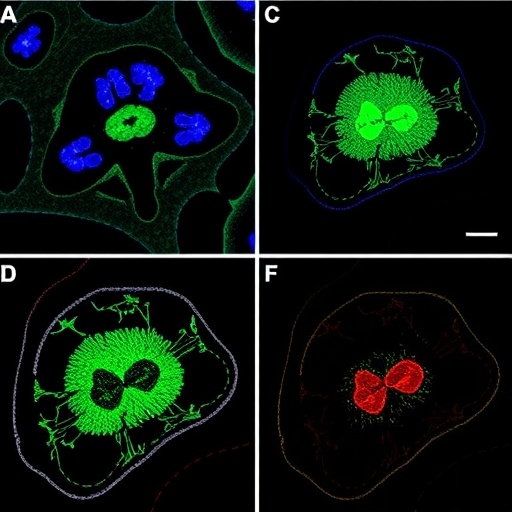Human papilloma virus (HPV) has long been recognized for its role in causing cervical cancer, but recent epidemiological shifts have placed HPV-associated head and neck cancers at the forefront of viral oncogenesis in the United States. Approximately 70 percent of head and neck cancers in the country are now attributable to HPV infection, with incidence rates climbing annually. Despite this alarming trend, unlike cervical cancer—which benefits from established screening protocols—there are currently no effective tests available for early detection of HPV-related head and neck malignancies. This gap in early diagnostic capability means that most patients are only identified once their tumors have escalated to enormous cellular volumes, often spreading to lymph nodes and presenting clinically overt symptoms.
In a breakthrough development, researchers at Mass General Brigham have pioneered an innovative liquid biopsy technology known as HPV-DeepSeek, which promises to revolutionize the early detection landscape for HPV-driven head and neck cancers. Published in the prestigious Journal of the National Cancer Institute, their study demonstrates that HPV-DeepSeek can identify circulating tumor HPV DNA in patient blood samples up to a decade before any clinical manifestation occurs. This advance holds profound implications for patient outcomes, as earlier detection generally leads to less aggressive treatment regimens and improved survival rates, minimizing the long-term morbidity associated with conventional therapeutic interventions.
What sets HPV-DeepSeek apart mechanistically is its use of whole-genome sequencing techniques to detect minuscule fragments of HPV DNA that are released into the bloodstream by incipient tumors. These circulating tumor DNA fragments serve as molecular harbingers, signaling the presence of a nascent malignancy. Prior research led by this team showcased the test’s remarkable sensitivity and specificity, achieving rates of 99 percent for both metrics when used at initial cancer diagnosis. This level of diagnostic accuracy surpasses that of existing modalities, marking HPV-DeepSeek as a potentially transformative tool in oncologic screening.
The current study involved a retrospective evaluation of 56 blood samples sourced from the Mass General Brigham Biobank. Investigators analyzed plasma collected from 28 patients who subsequently developed HPV-associated head and neck cancer and 28 age- and sex-matched healthy controls. Remarkably, HPV-DeepSeek accurately detected viral tumor DNA in 22 of the 28 pre-diagnostic samples, while none of the control samples exhibited positive results. This robust specificity underscores the test’s potential to reduce false positives—a critical factor in any screening tool aiming for widespread clinical application.
Interestingly, the detection sensitivity improved as samples were drawn closer to the eventual time of clinical diagnosis, highlighting a temporal association between circulating tumor DNA presence and disease progression. The study’s longest lead time for detection was nearly 7.8 years before clinical diagnosis, affirming that HPV-DeepSeek is capable of uncovering microscopic disease far earlier than current standards permit. Beyond this, application of sophisticated machine learning algorithms elevated the assay’s overall accuracy, enabling it to identify 27 out of 28 cancer cases, including samples collected up to a full decade before manifestation.
The mechanistic underpinnings of HPV-DeepSeek rest on its comprehensive sequencing of the HPV genome fragments circulating in patients’ blood. By mapping the entire viral genome rather than targeting specific loci, the test circumvents the limitations imposed by viral genetic variability and tumor heterogeneity. This holistic approach enhances the ability to pick up subtle tumor-derived DNA signals among background cell-free DNA, an obstacle that has hampered prior circulating tumor DNA assays.
This technological leap is particularly meaningful because head and neck cancers linked to HPV typically arise in oropharyngeal sites that are anatomically challenging to biopsy without invasive procedures. Consequently, non-invasive blood-based detection represents a paradigm shift, offering a patient-friendly approach that could seamlessly integrate into routine health check-ups. Early identification could empower clinicians to intervene before tumor expansion necessitates radical surgery, high-dose radiation, or chemotherapy, thereby sparing patients debilitating side effects including speech and swallowing difficulties.
As HPV-related head and neck cancers continue to increase, driven in part by changes in sexual behaviors and viral epidemiology, the public health burden intensifies. Screening strategies like HPV-DeepSeek may thus play a crucial role not only in clinical oncology but also in guiding preventative strategies, including vaccination efforts and targeted surveillance of high-risk populations. The study’s authors emphasize the urgent need to validate these findings in larger and more diverse cohorts to ensure generalizability and regulatory approval.
To this end, an ongoing blinded validation study funded by the National Institutes of Health is utilizing hundreds of plasma samples collected through the National Cancer Institute’s Prostate, Lung, Colorectal, and Ovarian Cancer Screening Trial (PLCO), one of the most comprehensive cancer biobanks in the United States. This trial will further probe HPV-DeepSeek’s specificity, sensitivity, and predictive power, aiming to lay the groundwork for eventual clinical implementation.
While clinical integration of such a liquid biopsy assay raises questions about cost-effectiveness, healthcare delivery logistics, and patient compliance, the potential gains in survival and quality of life offer a compelling argument for investment in continued research and development. Notably, lead author Dr. Daniel L. Faden highlights that earlier therapeutic interventions guided by this assay could dramatically reduce life-long treatment-related adverse effects endured by current patients who present with advanced tumors.
Beyond head and neck cancer, the conceptual framework established by HPV-DeepSeek opens avenues for detecting other virus-driven malignancies at preclinical stages. The intersection of next-generation sequencing, liquid biopsy, and artificial intelligence exemplifies the cutting edge of precision oncology, promising to pivot cancer care towards a future focused more on early detection and prevention rather than late-stage treatment.
In summary, HPV-DeepSeek represents a monumental advancement in diagnostic oncology, offering a highly sensitive, specific, and non-invasive method to detect HPV-associated head and neck cancers up to a decade before symptom onset. Its deployment in clinical settings could significantly alter the epidemiological trajectory of this disease, sparing countless patients from the suffering and loss of function that accompany current treatment approaches. As validation studies progress, this technology stands poised to become an integral component of cancer screening protocols worldwide.
Subject of Research: People
Article Title: Circulating tumor HPV DNA whole genome sequencing enables HPV-associated oropharynx cancer early detection
News Publication Date: 9-Sep-2025
Web References:
https://doi.org/10.1093/jnci/djaf249
https://www.massgeneralbrigham.org/en/about/newsroom/press-releases/hpv-deepseek-liquid-biopsy-head-and-neck-cancer-screening
References:
Das, D et al. “Circulating tumor HPV DNA whole genome sequencing enables HPV-associated oropharynx cancer early detection” JNCI DOI: 10.1093/jnci/djaf249
Keywords: Head and neck cancer, Cancer screening, Tumor growth, Sexually transmitted diseases
Tags: advancements in cancer diagnosisbreakthrough cancer detection methodscervical cancer screening protocolscirculating tumor DNA detectionearly detection of HPV malignanciesepidemiological trends in HPV infectionsHPV-associated head and neck cancersHPV-DeepSeek blood testimplications of early cancer detectionliquid biopsy technology for cancerMass General Brigham research on HPVoncogenesis in head and neck cancers





